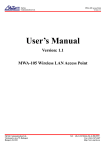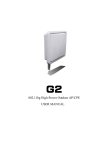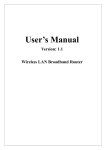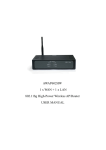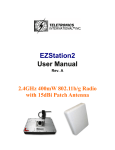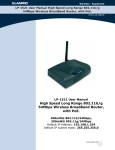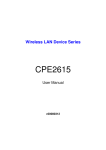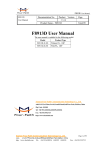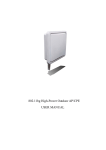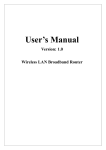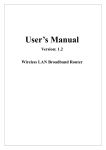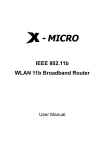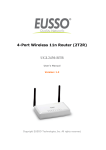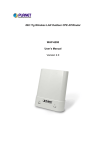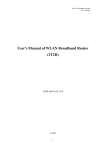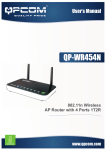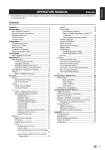Download User`s Manual
Transcript
User’s Manual BOSSW77 Wireless Radio CPE (Client Premises Equipment) USER’S MANUAL OF BOSSW77 WIRELESS RADIO CPE Version: 5.4 Table of Contents REVISION HISTORY ..................................................................................................................................................... IV 1. INTRODUCTION ..................................................................................................................................................... 1 1.1 FEATURES ........................................................................................................................................................................... 1 1.2 PRODUCT SPECIFICATIONS ..................................................................................................................................................... 2 1.3 PACKAGE CONTENTS ............................................................................................................................................................. 3 1.4 NETWORK LAYOUT .............................................................................................................................................................. 3 1.5 INSTALLATION CONSIDERATIONS ............................................................................................................................................. 3 1.6 APPLICATIONS ..................................................................................................................................................................... 4 2 SOFTWARE CONFIGURATION .............................................................................................................................. 10 2.1 PREPARE YOUR PC TO CONFIGURE THE WLAN BROADBAND AP ............................................................................................... 10 2.2 CONNECT TO THE WLAN BROADBAND AP ........................................................................................................................... 11 2.3 MANAGEMENT AND CONFIGURATION ON THE WLAN BROADBAND AP ..................................................................................... 11 2.3.1 Status ........................................................................................................................................................................... 11 2.3.2 Setup Wizard ............................................................................................................................................................... 13 2.3.3 Operation Mode .......................................................................................................................................................... 16 2.3.4 Wireless ‐ Basic Settings .............................................................................................................................................. 17 2.3.5 Wireless ‐ Advanced Settings ...................................................................................................................................... 19 2.3.6 Wireless ‐ Security Setup ............................................................................................................................................. 20 2.3.7 Wireless ‐ Access Control ............................................................................................................................................. 23 2.3.8 WDS Settings ............................................................................................................................................................... 24 2.3.9 Site Survey ................................................................................................................................................................... 26 2.3.10 LAN Interface Setup ............................................................................................................................................. 27 2.3.11 WAN Interface Setup ........................................................................................................................................... 29 2.3.12 Firewall ‐ Port Filtering ........................................................................................................................................ 36 2.3.13 Firewall ‐ IP Filtering ........................................................................................................................................... 37 2.3.14 Firewall ‐ MAC Filtering ....................................................................................................................................... 38 2.3.15 Firewall ‐ Port Forwarding ................................................................................................................................... 39 2.3.16 Firewall – URL Filtering ....................................................................................................................................... 40 2.3.17 Firewall ‐ DMZ ...................................................................................................................................................... 41 2.3.18 VPN Setting .......................................................................................................................................................... 42 2.3.19 Management ‐ Statistics ...................................................................................................................................... 47 2.3.20 Management ‐ DDNS ........................................................................................................................................... 48 2.3.21 Management ‐ Time Zone Setting....................................................................................................................... 48 2.3.22 Management – Denial‐of‐Service ........................................................................................................................ 49 2.3.23 Management ‐ Log .............................................................................................................................................. 50 ii USER’S MANUAL OF BOSSW77 WIRELESS RADIO CPE Version: 5.4 2.3.24 Management ‐ Upgrade Firmware ..................................................................................................................... 51 2.3.25 Management Save/ Reload Settings ................................................................................................................... 52 2.3.26 Management ‐ Password Setup .......................................................................................................................... 53 2.3.27 MANAGEMENT‐WATCHDOG ........................................................................................................................ 54 2.3.28 Management ‐ Quality of Service ....................................................................................................................... 55 2.3.29 Logout .................................................................................................................................................................. 57 3 FREQUENTLY ASKED QUESTIONS (FAQ) ............................................................................................................... 58 3.1 WHAT AND HOW TO FIND MY PC’S IP AND MAC ADDRESS? .................................................................................................... 58 3.2 WHAT IS WIRELESS LAN? .................................................................................................................................................. 58 3.3 WHAT ARE ISM BANDS? .................................................................................................................................................... 58 3.4 HOW DOES WIRELESS NETWORKING WORK? .......................................................................................................................... 58 3.5 WHAT IS BSSID? ............................................................................................................................................................. 58 3.6 WHAT IS ESSID? .............................................................................................................................................................. 59 3.7 WHAT ARE POTENTIAL FACTORS THAT MAY CAUSES INTERFERENCE? ........................................................................................... 59 3.8 WHAT ARE THE OPEN SYSTEM AND SHARED KEY AUTHENTICATIONS? ........................................................................................ 59 3.9 WHAT IS WEP? ............................................................................................................................................................... 59 3.10 WHAT IS FRAGMENT THRESHOLD? ...................................................................................................................................... 59 3.11 WHAT IS RTS (REQUEST TO SEND) THRESHOLD? ................................................................................................................... 60 3.12 WHAT IS BEACON INTERVAL? .............................................................................................................................................. 60 3.13 WHAT IS PREAMBLE TYPE?................................................................................................................................................. 60 3.14 WHAT IS SSID BROADCAST? .............................................................................................................................................. 60 3.15 WHAT IS WI‐FI PROTECTED ACCESS (WPA)? ........................................................................................................................ 61 3.16 WHAT IS WPA2? ............................................................................................................................................................. 61 3.17 WHAT IS 802.1X AUTHENTICATION? ................................................................................................................................... 61 3.18 WHAT IS TEMPORAL KEY INTEGRITY PROTOCOL (TKIP)? ......................................................................................................... 61 3.19 WHAT IS ADVANCED ENCRYPTION STANDARD (AES)? ............................................................................................................ 61 3.20 WHAT IS INTER‐ACCESS POINT PROTOCOL (IAPP)? ................................................................................................................ 61 3.21 WHAT IS WIRELESS DISTRIBUTION SYSTEM (WDS)? .............................................................................................................. 61 3.22 WHAT IS UNIVERSAL PLUG AND PLAY (UPNP)? ..................................................................................................................... 62 3.23 WHAT IS MAXIMUM TRANSMISSION UNIT (MTU) SIZE? ........................................................................................................ 62 3.24 WHAT IS CLONE MAC ADDRESS? ........................................................................................................................................ 62 3.25 WHAT IS DDNS? ............................................................................................................................................................. 62 3.26 WHAT IS NTP CLIENT? ...................................................................................................................................................... 62 3.27 WHAT IS VPN? ................................................................................................................................................................ 62 3.28 WHAT IS IPSEC? .............................................................................................................................................................. 62 4 TROUBLESHOOTING – Q & A .............................................................................................................................. 63 iii USER’S MANUAL OF BOSSW77 WIRELESS RADIO CPE Version: 5.4 Revision History DATE 2008/1/10 REVISION OF USER’S MANUAL Version 5.4 FIRMWARE (g/v)5.4 iv USER’S MANUAL OF BOSSW77 WIRELESS RADIO CPE Version: 5.4 1. Introduction BOSSW77 802.11b/g Outdoor Radio CPE with 12dBi Antenna & N‐type Conntector BOSSW77 outdoor CPE is an 802.11b/g low cost device for wireless solution. The device with integrated 12dBi patch antenna and N‐Type female antenna connector for higher gain antenna offers a cost‐effective solution for hotspot to make Point‐to‐Point and Point to Multi‐Point applications. All‐in‐One Device with Integrated 12 dBi Antenna and N‐Female Connector BOSSW77 is an all‐in‐one device with integrated Power Over Ethernet (PoE), 12dBi patch antenna, and the special designed waterproof cap for Ethernet RJ‐45 connector to access long distance of network without extra power adapter and extra booster to enlarge the output power. The built‐in N‐Female connector provides option for higher gain or type of antenna on your request. A complete package with a DC injector / 48V DC Power adapter , waterproof cap, and standard pole mount kit are included. 802.11B/G The BOSSW77 complies with IEEE802.11b/g 2.4GHz specifications. Through the Web management interface, you can run in Client, AP, Bridge, or WDS function. A multiples security functions including 64/128 bit WEP, WPA, Port filtering, IP filtering, MAC filtering, Port forwarding and DMZ Hosting to prevent unauthorized access are in protected. The QoS settings provide different levels of quality to different types of network traffic with WMM stands to improve audio, video and voice applications. The VPN function can be used to communicate many branch office. The unique ACK timeout value can be adjusted according to distance to ensure optimal throughput at various distances. 1.1 Features Integrated Powerful Radio and Antenna in an weatherproof enclosure Complies with IEEE 802.11b/g standard for 2.4GHz Wireless LAN Supports 64‐bit and 128‐bit WEP, WPA, WPA2 encryption/decryption function to protect the wireless data transmission. Supports IEEE 802.1x Authentication. Support Wi‐Fi Protected Access Authentication with Radius and Pre‐Shared Key mode. Supports Inter‐Access Point Protocol (IAPP). Supports Wireless Distribution System (WDS). Supports IEEE 802.3x full duplex flow control on 10/100M Ethernet interface. Supports DHCP server to provide clients auto IP addresses assignment. Supports DHCP client for WAN interface auto IP address assignment from ISP. Supports PPPoE on WAN interface. Supports PPTP Client on Ethernet WAN interface. Supports clone MAC address function. Supports firewall security with port filtering, IP filtering, MAC filtering, port forwarding, trigger port, DMZ hosting and URL filtering functions. Supports WEB based management and configuration. Supports UPnP for automatic Internet access. Supports Dynamic DNS service. Supports NTP client service. 1 USER’S MANUAL OF BOSSW77 WIRELESS RADIO CPE Version: 5.4 Supports Log table and remote Log service. Support Setup Wizard mode. Support DoS (Denial of Service) function. Support WMM function. Support Ping watchdog. Support QoS/Bandwidth Control function. 1.2 Product Specifications Interfaces Standard Frequency Band Modulation Technology Data Rate 10/100Mbps auto crossover Ethernet WAN Port (RJ45) (For connecting to 3rd party network device) Built‐in N‐Type female connector for higher gain antenna IEEE802.11b IEEE802.11g IEEE802.3 IEEE802.3u FCC : 2.412‐2.462 GHz (1‐11 channels) Europe (ETSI) : 2.412‐2.472 GHz (1‐13 channels) Japan : 2.412‐2.482 GHz (1‐13 channels) France : 2.457‐2.472 GHz (10‐13 channels) 802.11b: Direct Sequence Spread Spectrum (PBCC, CCK, DQPSK, DBPSK) 802.11g: Orthogonal frequency division multiplexing 802.11b: 11 Mbps, 5.5 Mbps, 2 Mbps, 1 Mbps 802.11g: 54 Mbps, 48 Mbps, 36 Mbps, 24 Mbps, 18 Mbps, 12 Mbps, 9 Mbps, 6 Mbps Transmit Power 26dBm/11b Sensitivity ‐80 dBm (11Mbps), ‐68 dBm(54Mbps) Operation Modes AP, Client, Bridge, and Repeater Modes Security Firmware 64bit/128 bit WEP, WPA, WPA2, IEEE802.1x Authentication, port filtering, IP filtering, MAC filtering, port forwarding, and DMZ hosting Web‐Based Management Tool Firmware upgrade via HTTP browser RADIUS server support Multi‐SSID WMM Dos (Denial of Service) Site Survey Antenna Type Integrated 12dBi flat panel antenna Dimension & Weight 165*150*75mm (0.7KGS) Environment Operating Temperature:‐30 ~ +70°C Humidity: C95%@55°C Enclosure IP65 UV resistant weatherproof enclosure Power Adapter 100‐240V(50‐60Hz) universal AC adapter (DC 48V) Power over Ethernet DC injector included Mounting Pole Mounting The specifications listed above are subject to change without prior notice 2 USER’S MANUAL OF BOSSW77 WIRELESS RADIO CPE Version: 5.4 1.3 Package contents 1. 2. 3. 4. 5. 6. CPE Waterproof Connector Plastic cover for N‐type connector 48V DC Power Adapter with base unit for PoE Mount kit User Manual CD 1.4 Network Layout BOSSW77 is compatible with 802.11g and 802.11b adapters. Since the 802.11g shares the same 2.4GHz radio band with the 802.11b technology, it can inter‐operate with existing 802.11b devices. Therefore, it can reserve your existing investment in 802.11b client cards such as the PC cards for laptop computers, PCI Card for the desktop PC, and USB Adapters. When connecting to wired network with wireless network, it’s network port can be used to connect any of switches, routers, and wireless Print Server. 1.5 Installation Considerations The WLAN device allow to access a network with a wireless connection from anywhere with its operating range. However, the effectively and efficiently range of WLAN device is affected by not only the number, thickness and location of walls, ceilings, or other objects that the wireless signals must pass through, but also the types of materials and background RF (radio frequency) noise in your home or business. To maximizing wireless range, follow up these basic guidelines: z Keep the WLAN device away (at least 3‐6 feet or 1‐2 meters) from other electrical devices or appliances that generate RF noise such as microwaves, monitors, electric motors. z Minimizing the numbers of walls and ceilings between the WLAN device and other network devices. Each wall or ceiling can reduce the WLAN device’s range from 3‐90 feet (1‐30 meters). z Position the WLAN antenna in a direct line to network devices for the best reception. A wall with 1.5 feet thick (.5 meters) at a 45‐degree angle is equal to 3 feet (1 meter) thick, at a 2‐degree angle is equal to 42 feet (14meters) thick. Positing the WLAN antenna that the signal will go straight through a wall or ceiling (instead of at an angle) for better reception. z Building Materials such as metal door and aluminum studs can impede the wireless signal. Try to best position WLAN device and computers to avoid the signal passes through those obstacles. 3 USER’S MANUAL OF BOSSW77 WIRELESS RADIO CPE Version: 5.4 1.6 Applications 4 USER’S MANUAL OF BOSSW77 WIRELESS RADIO CPE Version: 5.4 5 USER’S MANUAL OF BOSSW77 WIRELESS RADIO CPE Version: 5.4 6 USER’S MANUAL OF BOSSW77 WIRELESS RADIO CPE Version: 5.4 7 USER’S MANUAL OF BOSSW77 WIRELESS RADIO CPE Version: 5.4 8 USER’S MANUAL OF BOSSW77 WIRELESS RADIO CPE Version: 5.4 9 USER’S MANUAL OF BOSSW77 WIRELESS RADIO CPE Version: 5.4 Attention: z The cable distance between the Router and PC/hub/Switch should not exceed 100 meters. z Make sure the wiring is correct. To reliably operate your network at 100Mbps, you must use Category 5 cable, or better Data Grade. 2 Software configuration There are web based management and configuration functions allowing you to have the jobs done easily. The WLAN device is delivered with the following factory default parameters on the Ethernet LAN interfaces. Default IP Address: 192.168.1.254 Default IP subnet mask: 255.255.255.0 WEB login User Name: <empty> WEB login Password: <empty> 2.1 Prepare your PC to configure the WLAN Broadband AP For OS of Microsoft Windows 95/ 98/ Me: 1. Click the Start button and select Settings, then click Control Panel. The Control Panel window will appear. 2. Note: Windows Me users may not see the Network control panel. If so, select View all Control Panel options on the left side of the window 3. Move mouse and double‐click the right button on Network icon. The Network window will appear. 4. Check the installed list of Network Components. If TCP/IP is not installed, click the Add button to install it; otherwise go to step 6. 5. Select Protocol in the Network Component Type dialog box and click Add button. 6. Select TCP/IP in Microsoft of Select Network Protocol dialog box then click OK button to install the TCP/IP protocol, it may need the Microsoft Windows CD to complete the installation. Close and go back to Network dialog box after the TCP/IP installation. 7. Select TCP/IP and click the properties button on the Network dialog box. 8. Select Specify an IP address and type in values as following example. 9 IP Address: 192.168.1.254, any IP address within 192.168.1.1 to 192.168.1.253 is good to connect the Wireless LAN Access Point. 9 IP Subnet Mask: 255.255.255.0 9. Click OK and reboot your PC after completes the IP parameters setting. For OS of Microsoft Windows 2000, XP: 1. Click the Start button and select Settings, then click Control Panel. The Control Panel window will appear. 2. Move mouse and double‐click the right button on Network and Dial‐up Connections icon. Move mouse and double‐click the Local Area Connection icon. The Local Area Connection window will appear. Click Properties button in the Local Area Connection window. 3. Check the installed list of Network Components. If TCP/IP is not installed, click the Add button to install it; otherwise go to step 6. 4. Select Protocol in the Network Component Type dialog box and click Add button. 5. Select TCP/IP in Microsoft of Select Network Protocol dialog box then click OK button to install the 10 USER’S MANUAL OF BOSSW77 WIRELESS RADIO CPE Version: 5.4 TCP/IP protocol, it may need the Microsoft Windows CD to complete the installation. Close and go back to Network dialog box after the TCP/IP installation. 6. Select TCP/IP and click the properties button on the Network dialog box. 7. Select Specify an IP address and type in values as following example. 9 IP Address: 192.168.1.254, any IP address within 192.168.1.1 to 192.168.1.253 is good to connect the Wireless LAN Access Point. 9 IP Subnet Mask: 255.255.255.0 8. Click OK to complete the IP parameters setting. For OS of Microsoft Windows NT: 1. Click the Start button and select Settings, then click Control Panel. The Control Panel window will appear. 2. Move mouse and double‐click the right button on Network icon. The Network window will appear. Click Protocol tab from the Network window. 3. Check the installed list of Network Protocol window. If TCP/IP is not installed, click the Add button to install it; otherwise go to step 6. 4. Select Protocol in the Network Component Type dialog box and click Add button. 5. Select TCP/IP in Microsoft of Select Network Protocol dialog box then click OK button to install the TCP/IP protocol, it may need the Microsoft Windows CD to complete the installation. Close and go back to Network dialog box after the TCP/IP installation. 6. Select TCP/IP and click the properties button on the Network dialog box. 7. Select Specify an IP address and type in values as following example. 9 IP Address: 192.168.1.254, any IP address within 192.168.1.1 to 192.168.1.253 is good to connect the Wireless LAN Access Point. 9 IP Subnet Mask: 255.255.255.0 8. Click OK to complete the IP parameters setting. 2.2 Connect to the WLAN Broadband AP Open a WEB browser, i.e. Microsoft Internet Explore, then enter 192.168.1.254 on the URL to connect the WLAN device. 2.3 Management and configuration on the WLAN Broadband AP 2.3.1 Status This page shows the current status and some basic settings of the device, includes system, wireless, Ethernet LAN and WAN configuration information. 11 USER’S MANUAL OF BOSSW77 WIRELESS RADIO CPE Screen snapshot – Status Item Description System Uptime It shows the duration since WLAN device is powered on. Firmware version It shows the firmware version of WLAN device. Wireless configuration Mode It shows wireless operation mode Band It shows the current wireless operating frequency. SSID It shows the SSID of this WLAN device. The SSID is the unique name of WLAN device and shared among its service area, so all devices attempts to join the same wireless network can identify it. Channel Number It shows the wireless channel connected currently. Encryption It shows the status of encryption function. BSSID It shows the BSSID address of the WLAN device. BSSID is a six‐byte address. Associated Clients It shows the number of connected clients (or stations, PCs). TCP/IP configuration Attain IP Protocol It shows type of connection. IP Address It shows the IP address of LAN interfaces of WLAN device. Subnet Mask It shows the IP subnet mask of LAN interfaces of WLAN Version: 5.4 12 USER’S MANUAL OF BOSSW77 WIRELESS RADIO CPE Default Gateway DHCP Server MAC Address WAN configuration Attain IP Protocol IP Address Subnet Mask Default Gateway DNS1/DNS2/DNS3 MAC Address 2.3.2 Version: 5.4 device. It shows the default gateway setting for LAN interfaces outgoing data packets. It shows the DHCP server is enabled or not. It shows the MAC address of LAN interfaces of WLAN device. It shows how the WLAN device gets the IP address. The IP address can be set manually to a fixed one or set dynamically by DHCP server or attain IP by PPPoE / PPTP connection. It shows the IP address of WAN interface of WLAN device. It shows the IP subnet mask of WAN interface of WLAN device. It shows the default gateway setting for WAN interface outgoing data packets. It shows the DNS service information It shows the MAC address of WAN interface of WLAN device. Setup Wizard This page guides you to configure wireless broadband router for first time Screen snapshot – Setup Wizard I Operation Mode This page is used to configure which mode wireless broadband router acts 13 USER’S MANUAL OF BOSSW77 WIRELESS RADIO CPE Version: 5.4 Screen snapshot – Operation Mode II Time Zone Setting This page is used to enable and configure NTP client Screen snapshot – Time Zone Settings III LAN Interface Setup This page is used to configure local area network IP address and subnet mask 14 USER’S MANUAL OF BOSSW77 WIRELESS RADIO CPE Version: 5.4 Screen snapshot – LAN Interface Setup IV WAN Interface Setup This page is used to configure WAN access type Screen snapshot – WAN Interface Setup V Wireless Basic Settings This page is used to configure basic wireless parameters like Band, Mode, Network Type SSID, Channel Number, Enable Mac Clone (Single Ethernet Client) 15 USER’S MANUAL OF BOSSW77 WIRELESS RADIO CPE Version: 5.4 Screen snapshot – Wireless Basic Settings VI Wireless Security Setup This page is used to configure wireless security Screen snapshot – Wireless Security Setup 2.3.3 Operation Mode This page is used to configure which mode wireless broadband router acts 16 USER’S MANUAL OF BOSSW77 WIRELESS RADIO CPE Version: 5.4 Screen snapshot – Operation Mode Item Gateway Bridge Wireless ISP Apply Changes Reset 2.3.4 Description Traditional gateway configuration. It always connects internet via ADSL/Cable Modem. LAN interface, WAN interface, Wireless interface, NAT and Firewall modules are applied to this mode Each interface (LAN, WAN and Wireless) regards as bridge. NAT, Firewall and all router’s functions are not supported Switch Wireless interface to WAN port and all Ethernet ports in bridge mode. Wireless interface can do all router’s functions Click the Apply Changes button to complete the new configuration setting. Click the Reset button to abort change and recover the previous configuration setting. Wireless ‐ Basic Settings This page is used to configure the parameters for wireless LAN clients that may connect to your Broadband Router. Here you may change wireless encryption settings as well as wireless network parameters. 17 USER’S MANUAL OF BOSSW77 WIRELESS RADIO CPE Version: 5.4 Screen snapshot – Wireless Basic Settings Item Disable Wireless LAN Interface Band Mode SSID Channel Number Associated Clients Enable Mac Clone (Single Ethernet Client) Enable Universal Repeater Mode SSID of Extended Interface Apply Changes Reset Description Click on to disable the wireless LAN data transmission. Click to select 2.4GHz(B) / 2.4GHz(G) / 2.4GHz(B+G) Click to select the WLAN AP / Client / WDS / AP+WDS wireless mode. It is the wireless network name. The SSID can be 32 bytes long. Select the wireless communication channel from pull‐down menu. Click the Show Active Clients button to open Active Wireless Client Table that shows the MAC address, transmit‐packet, receive‐packet and transmission‐rate for each associated wireless client. Take Laptop NIC MAC address as wireless client MAC address. [Client Mode only] Click to enable Universal Repeater Mode Assign SSID when enables Universal Repeater Mode. Click the Apply Changes button to complete the new configuration setting. Click the Reset button to abort change and recover the previous configuration setting. 18 USER’S MANUAL OF BOSSW77 WIRELESS RADIO CPE 2.3.5 Version: 5.4 Wireless ‐ Advanced Settings These settings are only for more technically advanced users who have a sufficient knowledge about wireless LAN. These settings should not be changed unless you know what effect the changes will have on your WLAN device. Screen snapshot – Wireless Advanced Settings Item Authentication Type Fragment Threshold RTS Threshold Beacon Interval Data Rate Preamble Type Description Click to select the authentication type in Open System, Shared Key or Auto selection. Set the data packet fragmentation threshold, value can be written between 256 and 2346 bytes. Refer to 4.10 What is Fragment Threshold? Set the RTS Threshold, value can be written between 0 and 2347 bytes. Refer to 4.11 What is RTS(Request To Send) Threshold? Set the Beacon Interval, value can be written between 20 and 1024 ms. Refer to 4.12 What is Beacon Interval? Select the transmission data rate from pull‐down menu. Data rate can be auto‐select, 11M, 5.5M, 2M or 1Mbps. Click to select the Long Preamble or Short Preamble support on the wireless data packet transmission. Refer to 4.13 What is Preamble Type? 19 USER’S MANUAL OF BOSSW77 WIRELESS RADIO CPE Broadcast SSID IAPP 802.11g Protection Turbo Mode Block Relay Between Clients WMM ACK Timeout CCK Level Apply Changes Reset Version: 5.4 Click to enable or disable the SSID broadcast function. Refer to 4.14 What is SSID Broadcast? Click to enable or disable the IAPP function. Refer to 4.20 What is Inter‐Access Point Protocol(IAPP)? Protect 802.11b user. Click to enable/disable turbo mode. (Only apply to WLAN IC of Realtek). Click Enabled/Disabled to decide if blocking relay packets between clients. Click Enable/Disabled to init WMM feature. Set ACK timeout value. It shows current time in the end. To adjust transmission power level. Click the Apply Changes button to complete the new configuration setting. Click the Reset button to abort change and recover the previous configuration setting. 2.3.6 Wireless ‐ Security Setup This page allows you setup the wireless security. Turn on WEP, WPA, WPA2 by using encryption keys could prevent any unauthorized access to your wireless network. Screen snapshot – Wireless Security Setup 20 USER’S MANUAL OF BOSSW77 WIRELESS RADIO CPE Item Encryption Use 802.1x Authentication WPA Authentication Mode Pre‐Shared Key Format Pre‐Shared Key Enable Pre‐Authentication Authentication RADIUS Server Apply Changes Reset Version: 5.4 Description Select the encryption supported over wireless access. The encryption method can be None, WEP, WPA(TKIP), WPA2 or WPA2 Mixed Refer to 4.9 What is WEP? 4.15 What is Wi‐Fi Protected Access (WPA)? 4.16 What is WPA2(AES)? 4.17 What is 802.1X Authentication? 4.18 What is Temporal Key Integrity Protocol (TKIP)? 4.19 What is Advanced Encryption Standard (AES)? While Encryption is selected to be WEP. Click the check box to enable IEEE 802.1x authentication function. Refer to 4.16 What is 802.1x Authentication? While Encryption is selected to be WPA. Click to select the WPA Authentication Mode with Enterprise (RADIUS) or Personal (Pre‐Shared Key). Refer to 4.15 What is Wi‐Fi Protected Access (WPA)? While Encryption is selected to be WPA. Select the Pre‐shared key format from the pull‐down menu. The format can be Passphrase or Hex (64 characters). [WPA, Personal(Pre‐Shared Key) only] Fill in the key value. [WPA, Personal(Pre‐Shared Key) only] Click to enable Pre‐Authentication. [WPA2/WPA2 Mixed only, Enterprise only] Set the IP address, port and login password information of authentication RADIUS sever. Click the Apply Changes button to complete the new configuration setting. Click the Reset button to abort change and recover the previous configuration setting. 21 USER’S MANUAL OF BOSSW77 WIRELESS RADIO CPE Version: 5.4 I WEP Key Setup Screen snapshot – WEP Key Setup Item Description Key Length Select the WEP shared secret key length from pull‐down menu. The length can be chose between 64‐bit and 128‐bit (known as “WEP2”) keys. The WEP key is composed of initialization vector (24 bits) and secret key (40‐bit or 104‐bit). Key Format Select the WEP shared secret key format from pull‐down menu. The format can be chose between plant text (ASCII) and hexadecimal (HEX) code. Default Tx Key Set the default secret key for WEP security function. Value can be chose between 1 and 4. Encryption Key 1 Secret key 1 of WEP security encryption function. Encryption Key 2 Secret key 2 of WEP security encryption function. Encryption Key 3 Secret key 3 of WEP security encryption function. Encryption Key 4 Secret key 4 of WEP security encryption function. Apply Changes Click the Apply Changes button to complete the new configuration setting. Close Click to close this WEP Key setup window. Reset Click the Reset button to abort change and recover the previous configuration setting. 22 USER’S MANUAL OF BOSSW77 WIRELESS RADIO CPE WEP encryption key (secret key) length Length 64‐bit Format ASCII HEX 5 characters 10 hexadecimal codes Version: 5.4 128‐bit 13 characters 26 hexadecimal codes 2.3.7 Wireless ‐ Access Control If you enable wireless access control, only those clients whose wireless MAC addresses are in the access control list will be able to connect to your Access Point. When this option is enabled, no wireless clients will be able to connect if the list contains no entries. Screen snapshot – Wireless Access Control Item Description Wireless Access Control Click the Disabled, Allow Listed or Deny Listed of drop down Mode menu choose wireless access control mode. This is a security control function; only those clients registered in the access control list can link to this WLAN device. MAC Address Fill in the MAC address of client to register this WLAN device access capability. Comment Fill in the comment tag for the registered client. Apply Changes Click the Apply Changes button to register the client to new configuration setting. Reset Click the Reset button to abort change and recover the previous configuration setting. Current Access Control It shows the registered clients that are allowed to link to this 23 USER’S MANUAL OF BOSSW77 WIRELESS RADIO CPE List Delete Selected Delete All Reset 2.3.8 Version: 5.4 WLAN device. to delete the selected clients that will be access right removed from this WLAN device. Click to delete all the registered clients from the access allowed list. Click the Reset button to abort change and recover the previous configuration setting. WDS Settings Wireless Distribution System uses wireless media to communicate with other APs, like the Ethernet does. To do this, you must set these APs in the same channel and set MAC address of other AP that you want to communicate with in the table and then enable the WDS. Screen snapshot – WDS Setup Item Description Enable WDS the check box to enable wireless distribution system. Refer to 4.21 What is Wireless Distribution System (WDS)? MAC Address Fill in the MAC address of AP to register the wireless distribution system access capability. Comment Fill in the comment tag for the registered AP. Apply Changes Click the Apply Changes button to register the AP to new configuration setting. Reset Click the Reset button to abort change and recover the previous configuration setting. 24 USER’S MANUAL OF BOSSW77 WIRELESS RADIO CPE Set Security Show Statistics Delete Selected Delete All Reset Version: 5.4 Click button to configure wireless security like WEP(64bits), WEP(128bits), WPA(TKIP), WPA2(AES) or None It shows the TX, RX packets, rate statistics to delete the selected clients that will be removed from the wireless distribution system. Click to delete all the registered APs from the wireless distribution system allowed list. Click the Reset button to abort change and recover the previous configuration setting. I WDS Security Setup Requirement: Set [Wireless]‐>[Basic Settings]‐>[Mode]‐>AP+WDS This page is used to configure the wireless security between APs. Refer to 3.3.6 Wireless Security Setup. Screen snapshot – WDS Security Setup II WDS AP Table This page is used to show WDS statistics 25 USER’S MANUAL OF BOSSW77 WIRELESS RADIO CPE Version: 5.4 Screen snapshot – WDS AP Table Item MAC Address Tx Packets Tx Errors Rx Packets Tx Rare (Mbps) Refresh Close 2.3.9 Description It shows the MAC Address within WDS. It shows the statistic count of sent packets on the wireless LAN interface. It shows the statistic count of error sent packets on the Wireless LAN interface. It shows the statistic count of received packets on the wireless LAN interface. It shows the wireless link rate within WDS. Click to refresh the statistic counters on the screen. Click to close the current window. Site Survey This page is used to view or configure other APs near yours. 26 USER’S MANUAL OF BOSSW77 WIRELESS RADIO CPE Version: 5.4 Screen snapshot – Wireless Site Survey Item Description SSID It shows the SSID of AP. BSSID It shows BSSID of AP. Channel It show the current channel of AP occupied. Type It show which type AP acts. Encrypt It shows the encryption status. Signal It shows the power level of current AP. Select Click to select AP or client you’d like to connect Refresh Click the Refresh button to re‐scan site survey on the screen. Connect Click the Connect button to establish connection. 2.3.10 LAN Interface Setup This page is used to configure the parameters for local area network that connects to the LAN ports of your WLAN device. Here you may change the setting for IP address, subnet mask, DHCP, etc. 27 USER’S MANUAL OF BOSSW77 WIRELESS RADIO CPE Version: 5.4 Screen snapshot – LAN Interface Setup Item IP Address Subnet Mask Default Gateway DHCP DHCP Client Range Show Client Domain Name 802.1d Spanning Tree Clone MAC Address Apply Changes Reset Description Fill in the IP address of LAN interfaces of this WLAN Access Point. Fill in the subnet mask of LAN interfaces of this WLAN Access Point. Fill in the default gateway for LAN interfaces out going data packets. Click to select Disabled, Client or Server in different operation mode of wireless Access Point. Fill in the start IP address and end IP address to allocate a range of IP addresses; client with DHCP function set will be assigned an IP address from the range. Click to open the Active DHCP Client Table window that shows the active clients with their assigned IP address, MAC address and time expired information. [Server mode only] Assign Domain Name and dispatch to DHCP clients. It is optional field. Select to enable or disable the IEEE 802.1d Spanning Tree function from pull‐down menu. Fill in the MAC address that is the MAC address to be cloned. Refer to 4.24 What is Clone MAC Address? Click the Apply Changes button to complete the new configuration setting. Click the Reset button to abort change and recover the previous configuration setting. 28 USER’S MANUAL OF BOSSW77 WIRELESS RADIO CPE I Version: 5.4 Active DHCP Client Table This table shows the assigned IP address, MAC address, and time expired for each DHCP leased client. Screen snapshot – WAN Interface Setup – Active DHCP Client Table 2.3.11 WAN Interface Setup This page is used to configure the parameters for wide area network that connects to the WAN port of your WLAN device. Here you may change the access method to Static IP, DHCP, PPPoE or PPTP by click the item value of WAN Access Type. 29 USER’S MANUAL OF BOSSW77 WIRELESS RADIO CPE I Version: 5.4 Static IP Screen snapshot – WAN Interface Setup – Static IP Item Description Static IP Click to select Static IP support on WAN interface. There are IP address, subnet mask and default gateway settings need to be done. IP Address If you select the Static IP support on WAN interface, fill in the IP address for it. Subnet Mask If you select the Static IP support on WAN interface, fill in the subnet mask for it. Default Gateway If you select the Static IP support on WAN interface, fill in the default gateway for WAN interface out going data packets. MTU Size Fill in the mtu size of MTU Size. The default value is 1400 DNS 1 Fill in the IP address of Domain Name Server 1. DNS 2 Fill in the IP address of Domain Name Server 2. DNS 3 Fill in the IP address of Domain Name Server 3. Clone MAC Address Fill in the MAC address that is the MAC address to be cloned. Refer to 4.24 What is Clone MAC Address? 30 USER’S MANUAL OF BOSSW77 WIRELESS RADIO CPE Enable uPNP Enable Web Server Access on WAN Enable IPsec pass through on VPN connection Enable PPTP pass through on VPN connection Enable L2TP pass through on VPN connection Set TTL value Apply Changes Reset Version: 5.4 Click the checkbox to enable uPNP function. Refer to 4.22 What is Universal Plug and Play (uPNP)? Click the checkbox to enable web configuration from WAN side. Click the checkbox to enable IPSec packet pass through Click the checkbox to enable PPTP packet pass through Click the checkbox to enable L2TP packet pass through Click to Enable and set Time to Live value Click the Apply Changes button to complete the new configuration setting. Click the Reset button to abort change and recover the previous configuration setting. II DHCP Client Screen snapshot – WAN Interface Setup – DHCP Client 31 USER’S MANUAL OF BOSSW77 WIRELESS RADIO CPE Item DHCP Client Host Name MTU Size Attain DNS Automatically Set DNS Manually DNS 1 DNS 2 DNS 3 Clone MAC Address Enable uPNP Enable Web Server Access on WAN Enable IPsec pass through on VPN connection Enable PPTP pass through on VPN connection Enable L2TP pass through on VPN connection Set TTL value Apply Changes Reset Version: 5.4 Description Click to select DHCP support on WAN interface for IP address assigned automatically from a DHCP server. Fill in the host name of Host Name. The default value is empty Fill in the mtu size of MTU Size. The default value is 1400 Click to select getting DNS address for DHCP support. Please select Set DNS Manually if the DHCP support is selected. Click to select getting DNS address for DHCP support. Fill in the IP address of Domain Name Server 1. Fill in the IP address of Domain Name Server 2. Fill in the IP address of Domain Name Server 3. Fill in the MAC address that is the MAC address to be cloned. Refer to 4.24 What is Clone MAC Address? Click the checkbox to enable uPNP function. Refer to 4.22 What is Universal Plug and Play (uPNP)? Click the checkbox to enable web configuration from WAN side. Click the checkbox to enable IPSec packet pass through Click the checkbox to enable PPTP packet pass through Click the checkbox to enable L2TP packet pass through Click to Enable and set Time to Live value. Click the Apply Changes button to complete the new configuration setting. Click the Reset button to abort change and recover the previous configuration setting. 32 USER’S MANUAL OF BOSSW77 WIRELESS RADIO CPE III Version: 5.4 PPPoE Screen snapshot – WAN Interface Setup – PPPoE Item Description PPPoE Click to select PPPoE support on WAN interface. There are user name, password, connection type and idle time settings need to be done. User Name If you select the PPPoE support on WAN interface, fill in the user name and password to login the PPPoE server. Password If you select the PPPoE support on WAN interface, fill in the user name and password to login the PPPoE server. Service Name Fill in the service name of Service Name. The default value is empty. Connection Type Select the connection type from pull‐down menu. There are Continuous, Connect on Demand and Manual three types to 33 USER’S MANUAL OF BOSSW77 WIRELESS RADIO CPE Idle Time MTU Size Attain DNS Automatically Set DNS Manually DNS 1 DNS 2 DNS 3 Clone MAC Address Enable uPNP Enable Web Server Access on WAN Enable IPsec pass through on VPN connection Enable PPTP pass through on VPN connection Enable L2TP pass through on VPN connection Set TTL value Apply Changes Reset Version: 5.4 select. Continuous connection type means to setup the connection through PPPoE protocol whenever this WLAN device is powered on. Connect on Demand connection type means to setup the connection through PPPoE protocol whenever you send the data packets out through the WAN interface; there are a watchdog implemented to close the PPPoE connection while there are no data sent out longer than the idle time set. Manual connection type means to setup the connection through the PPPoE protocol by clicking the Connect button manually, and clicking the Disconnect button manually. If you select the PPPoE and Connect on Demand connection type, fill in the idle time for auto‐disconnect function. Value can be between 1 and 1000 minutes. Fill in the mtu size of MTU Size. The default value is 1400. Refer to 4.23 What is Maximum Transmission Unit (MTU) Size? Click to select getting DNS address for PPPoE support. Please select Set DNS Manually if the PPPoE support is selected. Click to select getting DNS address for Static IP support. Fill in the IP address of Domain Name Server 1. Fill in the IP address of Domain Name Server 2. Fill in the IP address of Domain Name Server 3. Fill in the MAC address that is the MAC address to be cloned. Refer to 4.24 What is Clone MAC Address? Click the checkbox to enable uPNP function. Refer to 4.22 What is Universal Plug and Play (uPNP)? Click the checkbox to enable web configuration from WAN side. Click the checkbox to enable IPSec packet pass through Click the checkbox to enable PPTP packet pass through Click the checkbox to enable L2TP packet pass through Click to Enable and set Time to Live value Click the Apply Changes button to complete the new configuration setting. Click the Reset button to abort change and recover the previous configuration setting. 34 USER’S MANUAL OF BOSSW77 WIRELESS RADIO CPE IV Version: 5.4 PPTP Screen snapshot – WAN Interface Setup – PPTP Item PPTP IP Address Subnet Mask Server IP Address User Name Description Allow user to make a tunnel with remote site directly to secure the data transmission among the connection. User can use embedded PPTP client supported by this router to make a VPN connection. If you select the PPTP support on WAN interface, fill in the IP address for it. If you select the PPTP support on WAN interface, fill in the subnet mask for it. Enter the IP address of the PPTP Server. If you select the PPTP support on WAN interface, fill in the user name and password to login the PPTP server. 35 USER’S MANUAL OF BOSSW77 WIRELESS RADIO CPE Version: 5.4 Password f you select the PPTP support on WAN interface, fill in the user name and password to login the PPTP server. MTU Size Fill in the mtu size of MTU Size. The default value is 1400. Refer to 4.23 What is Maximum Transmission Unit (MTU) Size? Request MPPE Encryption Click the checkbox to enable request MPPE encryption. Attain DNS Automatically Click to select getting DNS address for PPTP support. Please select Set DNS Manually if the PPTP support is selected. Set DNS Manually Click to select getting DNS address for PPTP support. DNS 1 Fill in the IP address of Domain Name Server 1. DNS 2 Fill in the IP address of Domain Name Server 2. DNS 3 Fill in the IP address of Domain Name Server 3. Clone MAC Address Fill in the MAC address that is the MAC address to be cloned. Refer to 4.24 What is Clone MAC Address? Enable uPNP Click the checkbox to enable uPNP function. Refer to 4.22 What is Universal Plug and Play (uPNP)? Enable Web Server Access Click the checkbox to enable web configuration from WAN on WAN side. Enable IPsec pass through Click the checkbox to enable IPSec packet pass through on VPN connection Enable PPTP pass through Click the checkbox to enable PPTP packet pass through on VPN connection Enable L2TP pass through Click the checkbox to enable L2TP packet pass through on VPN connection Set TTL value Click to Enable and set Time to Live value. Apply Changes Click the Apply Changes button to complete the new configuration setting. Reset Click the Reset button to abort change and recover the previous configuration setting. 2.3.12 Firewall ‐ Port Filtering Entries in this table are used to restrict certain types of data packets from your local network to Internet through the Gateway. Use of such filters can be helpful in securing or restricting your local network. 36 USER’S MANUAL OF BOSSW77 WIRELESS RADIO CPE Version: 5.4 Screen snapshot – Firewall ‐ Port Filtering Item Description Enable Port Filtering Click to enable the port filtering security function. Port Range To restrict data transmission from the local network on Protocol certain ports, fill in the range of start‐port and end‐port, and Comments the protocol, also put your comments on it. The Protocol can be TCP, UDP or Both. Comments let you know about whys to restrict data from the ports. Apply Changes Click the Apply Changes button to register the ports to port filtering list. Reset Click the Reset button to abort change and recover the previous configuration setting. Delete Selected Click to delete the selected port range that will be removed from the port‐filtering list. Delete All Click to delete all the registered entries from the port‐filtering list. Reset Click the Reset button to abort change and recover the previous configuration setting. 2.3.13 Firewall ‐ IP Filtering Entries in this table are used to restrict certain types of data packets from your local network to Internet through the Gateway. Use of such filters can be helpful in securing or restricting your local network. 37 USER’S MANUAL OF BOSSW77 WIRELESS RADIO CPE Version: 5.4 Screen snapshot – Firewall ‐ IP Filtering Item Description Enable IP Filtering Click to enable the IP filtering security function. Local IP Address To restrict data transmission from local network on certain IP Protocol addresses, fill in the IP address and the protocol, also put Comments your comments on it. The Protocol can be TCP, UDP or Both. Comments let you know about whys to restrict data from the IP address. Apply Changes Click the Apply Changes button to register the IP address to IP filtering list. Reset Click the Reset button to abort change and recover the previous configuration setting. Delete Selected Click to delete the selected IP address that will be removed from the IP‐filtering list. Delete All Click to delete all the registered entries from the IP‐filtering list. Reset Click the Reset button to abort change and recover the previous configuration setting. 2.3.14 Firewall ‐ MAC Filtering Entries in this table are used to restrict certain types of data packets from your local network to Internet through the Gateway. Use of such filters can be helpful in securing or restricting your local network. 38 USER’S MANUAL OF BOSSW77 WIRELESS RADIO CPE Version: 5.4 Screen snapshot – Firewall ‐ MAC Filtering Item Description Enable MAC Filtering Click to enable the MAC filtering security function. MAC Address To restrict data transmission from local network on certain Comments MAC addresses, fill in the MAC address and your comments on it. Comments let you know about whys to restrict data from the MAC address. Apply Changes Click the Apply Changes button to register the MAC address to MAC filtering list. Reset Click the Reset button to abort change and recover the previous configuration setting. Delete Selected Click to delete the selected MAC address that will be removed from the MAC‐filtering list. Delete All Click to delete all the registered entries from the MAC‐filtering list. Reset Click the Reset button to abort change and recover the previous configuration setting. 2.3.15 Firewall ‐ Port Forwarding Entries in this table allow you to automatically redirect common network services to a specific machine behind the NAT firewall. These settings are only necessary if you wish to host some sort of server like a web server or mail server on the private local network behind your Gateway's NAT firewall. 39 USER’S MANUAL OF BOSSW77 WIRELESS RADIO CPE Version: 5.4 Screen snapshot – Firewall ‐ Port Forwarding Item Description Enable Port Forwarding Click to enable the Port Forwarding security function. IP Address To forward data packets coming from WAN to a specific IP Protocol address that hosted in local network behind the NAT firewall, fill in the IP address, protocol, port range and your Port Range Comment comments. The Protocol can be TCP, UDP or Both. The Port Range for data transmission. Comments let you know about whys to allow data packets forward to the IP address and port number. Apply Changes Click the Apply Changes button to register the IP address and port number to Port forwarding list. Reset Click the Reset button to abort change and recover the previous configuration setting. Delete Selected Click to delete the selected IP address and port number that will be removed from the port‐forwarding list. Delete All Click to delete all the registered entries from the port‐forwarding list. Reset Click the Reset button to abort change and recover the previous configuration setting. 2.3.16 Firewall – URL Filtering URL Filtering is used to restrict users to access specific websites in internet. 40 USER’S MANUAL OF BOSSW77 WIRELESS RADIO CPE Version: 5.4 Screen snapshot – Firewall – URL Filtering Item Enable URL Filtering URL Address Apply Changes Reset Delete Selected Delete All Reset 2.3.17 Description Click to enable the URL Filtering function. Add one URL address. Click the Apply Changes button to save settings. Click the Reset button to abort change and recover the previous configuration setting. Click to delete the selected URL address that will be removed from the URL Filtering list. Click to delete all the registered entries from the URL Filtering list. Click the Reset button to abort change and recover the previous configuration setting. Firewall ‐ DMZ A Demilitarized Zone is used to provide Internet services without sacrificing unauthorized access to its local private network. Typically, the DMZ host contains devices accessible to Internet traffic, such as Web (HTTP) servers, FTP servers, SMTP (e‐mail) servers and DNS servers. 41 USER’S MANUAL OF BOSSW77 WIRELESS RADIO CPE Version: 5.4 Screen snapshot – Firewall ‐ DMZ Item Enable DMZ DMZ Host IP Address Apply Changes Reset 2.3.18 Description Click to enable the DMZ function. To support DMZ in your firewall design, fill in the IP address of DMZ host that can be access from the WAN interface. Click the Apply Changes button to register the IP address of DMZ host. Click the Reset button to abort change and recover the previous configuration setting. VPN Setting This page is used to show VPN connection table, configure IPSEC VPN, NAT Traversal, Generate RSA Key, show RSA Public Key. 42 USER’S MANUAL OF BOSSW77 WIRELESS RADIO CPE Version: 5.4 Screen snapshot – VPN Setup Item Description Enable IPSEC VPN Click to enable IPSEC VPN function. Refer to 4.27 What is VPN? And 4.28 What is IPSEC? Enable NAT Traversal Click to enable NAT Traversal function. Generate RSA Key Click to generate RSA key. Show RSA Public Key Click to show RSA public key that we generate. Apply Changes Click the Apply Changes button to enable IPSEC VPN, NAT Traversal settings. Current VPN Connection It shows current WAN interface information and VPN Table connection table. Edit Click to enter the current VPN tunnel configuration page. Delete Click to delete the current VPN tunnel that radio button stay. Refresh Click to refresh the current VPN connection table. 43 USER’S MANUAL OF BOSSW77 WIRELESS RADIO CPE I Version: 5.4 VPN Setup ‐ Edit Tunnel Screen snapshot – VPN Setup‐Edit Tunnel Item Description Enable Tunnel 1 Click to enable the IPSEC VPN current tunnel. Connection Name Assign the connection name tag. Auth Type Click to select PSK or RSA. Local Site Click to select Single Address or Subnet Address VPN connection. Local IP Fill in IP address or subnet address depends on which Local Address/Network Site option you choose. Local Subnet Mask Fill in the local subnet mask. Remote Site Click to select Single Address, Subnet Address, Any Address or NAT‐T Any Address VPN remote connection. Remote Secure Gateway Fill in remote gateway IP address Remote IP Address/Network Fill in IP address or subnet address depends on which Remote Subnet Mask Remote Site option you choose. 44 USER’S MANUAL OF BOSSW77 WIRELESS RADIO CPE Local/Peer ID Local ID Type Local ID Remote ID Type Remote ID Key Management Advanced Connection Type Connect Disconnect ESP PreShared Key Remote RSA Key Status SPI Encryption Key Authentication Key Apply Change Reset Refresh Back Version: 5.4 Fill in remote subnet mask Define IKE exchange information type Click to select IP, DNS or E‐mail as local exchange type Fill in local ID except IP selected Click to select IP, DNS or E‐mail as remote exchange type Fill in remote ID except IP selected Click to select IKE or Manual mode. Click Advanced button to configure more IKE settings. Click to select Initiator or Responder mode. Click to connect manually. [Responder mode only] Click to disconnect manually. [Responder mode only]. Click to configure 3DES, AES128 or NULL encryption. Click to configure MD5 or SHA1 authentication. Fill in the key value. [IKE mode only] Fill in the remote gateway RSA key. [IKE mode only] It shows connection status. [IKE mode only] Fill in Security Parameter Index value. [Manual mode only] Fill in encryption key. [Manual mode only] Fill in authentication key. [Manual mode only] Click the Apply Changes button to save current tunnel settings. Click the Reset button to abort change and recover the previous configuration setting. It shows the current connection status. [Manual mode only] It returns back to VPN Setup page. 45 USER’S MANUAL OF BOSSW77 WIRELESS RADIO CPE II Version: 5.4 Advanced IKE Setup Screen snapshot – Advanced VPN Settings for IKE Item Description Phase 1 Negotiation Mode Main mode. Encryption Algorithm Click to select 3DES or AES128 encryption. Authentication Click to select MD5 or SHA1 authentication. Algorithm Key Group Click to select DH1(modp768), DH2(modp1024) or DH5(modp1536) key group. Default value is DH2 Key Life Time Fill in the key life time value by seconds. Phase 2 Active Protocol ESP. Encryption Algorithm Click to select 3DES, AES128 or NULL encryption. Authentication Click to select MD5 or SHA1 authentication. Algorithm 46 USER’S MANUAL OF BOSSW77 WIRELESS RADIO CPE Key Life Time Encapsulation Perfect Forward Secrecy (PFS) Ok Cancel Version: 5.4 Fill in the key life time value by seconds. Tunnel mode. Click to select ON or NONE. Click the Ok button to save current tunnel settings. Click the Cancel button to close current window without any changes. 2.3.19 Management ‐ Statistics This page shows the packet counters for transmission and reception regarding to wireless, Ethernet LAN and Ethernet WAN networks. Screen snapshot – Management ‐ Statistics Item Description Wireless LAN It shows the statistic count of sent packets on the wireless Sent Packets LAN interface. Wireless LAN It shows the statistic count of received packets on the Received Packets wireless LAN interface. Ethernet LAN It shows the statistic count of sent packets on the Ethernet Sent Packets LAN interface. Ethernet LAN It shows the statistic count of received packets on the Received Packets Ethernet LAN interface. Ethernet WAN It shows the statistic count of sent packets on the Ethernet Sent Packets WAN interface. Ethernet WAN It shows the statistic count of received packets on the 47 USER’S MANUAL OF BOSSW77 WIRELESS RADIO CPE Received Packets Refresh 2.3.20 Version: 5.4 Ethernet WAN interface. Click the refresh the statistic counters on the screen. Management ‐ DDNS This page is used to configure Dynamic DNS service to have DNS with dynamic IP address. Screen snapshot – Management – DDNS Item Description Enable DDNS Click the checkbox to enable DDNS service. Refer to 4.25 What is DDNS? Service Provider Click the drop down menu to pickup the right provider. Domain Name To configure the Domain Name. User Name/Email Configure User Name, Email. Password/Key Configure Password, Key. Apply Change Click the Apply Changes button to save the enable DDNS service. Reset Click the Reset button to abort change and recover the previous configuration setting. 2.3.21 Management ‐ Time Zone Setting This page is used to configure NTP client to get current time. 48 USER’S MANUAL OF BOSSW77 WIRELESS RADIO CPE Version: 5.4 Screen snapshot – Management – Time Zone Settings Item Description Current Time It shows the current time. Time Zone Select Click the time zone in your country. Enable NTP client Click the checkbox to enable NTP client update. Refer to 4.26 update What is NTP Client? NTP Server Click select default or input NTP server IP address. Apply Change Click the Apply Changes button to save and enable NTP client service. Reset Click the Reset button to abort change and recover the previous configuration setting. Refresh Click the refresh the current time shown on the screen. 2.3.22 Management – Denial‐of‐Service This page is used to enable and setup protection to prevent attack by hacker’s program. It provides more security for users. 49 USER’S MANUAL OF BOSSW77 WIRELESS RADIO CPE Version: 5.4 Screen snapshot – Management – Denial‐of‐Service Item Enable DoS Prevention Whole System Flood / Per‐Source IP Flood… Select ALL Clear ALL Apply Changes Description Click the checkbox to enable DoS prevention. Enable and setup prevention in details. Click the checkbox to enable all prevention items. Click the checkbox to disable all prevention items. Click the Apply Changes button to save above settings. 2.3.23 Management ‐ Log This page is used to configure the remote log server and shown the current log. 50 USER’S MANUAL OF BOSSW77 WIRELESS RADIO CPE Version: 5.4 Screen snapshot – Management – Log Item Description Enable Log Click the checkbox to enable log. System all Show all log of wireless broadband router Wirelessy Only show wireless log DoS Only show Denial‐of‐Service log Enable Remote Log Click the checkbox to enable remote log service. Log Server IP Address Input the remote log IP address Apply Changes Click the Apply Changes button to save above settings. Refresh Click the refresh the log shown on the screen. Clear Clear log display screen 2.3.24 Management ‐ Upgrade Firmware This page allows you upgrade the Access Point firmware to new version. Please note, do not power off the device during the upload because it may crash the system. 51 USER’S MANUAL OF BOSSW77 WIRELESS RADIO CPE Version: 5.4 Screen snapshot – Management ‐ Upgrade Firmware Item Select File Upload Reset Description Click the Browse button to select the new version of web firmware image file. Click the Upload button to update the selected web firmware image to the WLAN device. Click the Reset button to abort change and recover the previous configuration setting. 2.3.25 Management Save/ Reload Settings This page allows you save current settings to a file or reload the settings from the file that was saved previously. Besides, you could reset the current configuration to factory default. 52 USER’S MANUAL OF BOSSW77 WIRELESS RADIO CPE Version: 5.4 Screen snapshot – Management ‐ Save/Reload Settings Item Description Save Settings to File Click the Save button to download the configuration parameters to your personal computer. Load Settings from File Click the Browse button to select the configuration files then click the Upload button to update the selected configuration to the WLAN device. Reset Settings to Default Click the Reset button to reset the configuration parameter to factory defaults. 2.3.26 Management ‐ Password Setup This page is used to set the account to access the web server of Access Point. Empty user name and password will disable the protection. 53 USER’S MANUAL OF BOSSW77 WIRELESS RADIO CPE Version: 5.4 Screen snapshot – Management ‐ Password Setup Item User Name New Password Confirmed Password Apply Changes Reset Description Fill in the user name for web management login control. Fill in the password for web management login control. Because the password input is invisible, so please fill in the password again for confirmation purpose. Clear the User Name and Password fields to empty, means to apply no web management login control. Click the Apply Changes button to complete the new configuration setting. Click the Reset button to abort change and recover the previous configuration setting. 2.3.27 Management‐WatchDog This page is used to do watchdog function using ping command. User set IP address, interval and ping fail account conditions to decide whether router reboots or not 54 USER’S MANUAL OF BOSSW77 WIRELESS RADIO CPE Version: 5.4 Screen snapshot – Management – WatchDog Setting Item Enable WatchDog WatchDog IP Address Ping Interval Ping Fail to reboot Count Apply Changes Reset 2.3.28 Description Click to enable watchdog. IP address that is referred. Fill in the value by seconds. Fill in the value that is the threshold to reboot router when ping fails. Click the Apply Changes button to complete the new configuration setting. Click the Reset button to abort change and recover the previous configuration setting. Management ‐ Quality of Service This page is used to do bandwidth control by IP address. User sets total and undefined bandwidth first. Then set bandwidth by range of IP addresses. 55 USER’S MANUAL OF BOSSW77 WIRELESS RADIO CPE Version: 5.4 Screen snapshot – Management – Qaulity of Service Item Enable QoS ISP Bandwidth Download Upload Undef IP Bandwidth Download Upload Apply Changes Reset Bandwidth Control IP Address Range Guarantee Bandwidth Download Upload Priority Apply Changes Reset Description Click to enable QoS. Fill in the value that is the download stream from ISP by KB/s. Fill in the value that is the upload stream from ISP by KB/s. Define the download bandwidth that is not defined. Define the upload bandwidth that is not defined. Click the Apply Changes button to complete the new configuration setting. Click the Reset button to abort change and recover the previous configuration setting. Set start and end ip address. Fill in the value by KB/s. Fill in the value by KB/s. Click to pick High, Medium or Low Click the Apply Changes button to complete the new configuration setting. It is added into Current Bandwidth Control Table. Click the Reset button to abort change and recover the previous configuration setting. 56 USER’S MANUAL OF BOSSW77 WIRELESS RADIO CPE Delete Selected Delete All Reset 2.3.29 Version: 5.4 Click to delete the selected IP addresses that will be removed from the Current Bandwidth Control Table. Click to delete all the registered entries from the IP addresses Current Bandwidth Control Table. Click the Reset button to abort change and recover the previous configuration setting. Logout This page is used to logout web management page. This item will be activated next time you login after you define user account and password. Screen snapshot – Logout Screen snapshot – Logout ‐ OK Item Apply Change Description Click the Apply Change button, Then click OK button to logout. 57 USER’S MANUAL OF BOSSW77 WIRELESS RADIO CPE 3 Version: 5.4 Frequently Asked Questions (FAQ) 3.1 What and how to find my PC’s IP and MAC address? IP address is the identifier for a computer or device on a TCP/IP network. Networks using the TCP/IP protocol route messages based on the IP address of the destination. The format of an IP address is a 32‐bit numeric address written as four numbers separated by periods. Each number can be zero to 255. For example, 192.168.1.254 could be an IP address. The MAC (Media Access Control) address is your computer's unique hardware number. (On an Ethernet LAN, it's the same as your Ethernet address.) When you're connected to the Internet from your computer (or host as the Internet protocol thinks of it), a correspondence table relates your IP address to your computer's physical (MAC) address on the LAN. To find your PC’s IP and MAC address, 9 Open the Command program in the Microsoft Windows. 9 Type in ipconfig /all then press the Enter button. ¾ Your PC’s IP address is the one entitled IP Address and your PC’s MAC address is the one entitled Physical Address. 3.2 What is Wireless LAN? A wireless LAN (WLAN) is a network that allows access to Internet without the need for any wired connections to the user’s machine. 3.3 What are ISM bands? ISM stands for Industrial, Scientific and Medical; radio frequency bands that the Federal Communications Commission (FCC) authorized for wireless LANs. The ISM bands are located at 915 +/‐ 13 MHz, 2450 +/‐ 50 MHz and 5800 +/‐ 75 MHz. 3.4 How does wireless networking work? The 802.11 standard define two modes: infrastructure mode and ad hoc mode. In infrastructure mode, the wireless network consists of at least one access point connected to the wired network infrastructure and a set of wireless end stations. This configuration is called a Basic Service Set (BSS). An Extended Service Set (ESS) is a set of two or more BSSs forming a single subnetwork. Since most corporate WLANs require access to the wired LAN for services (file servers, printers, Internet links) they will operate in infrastructure mode. Ad hoc mode (also called peer‐to‐peer mode or an Independent Basic Service Set, or IBSS) is simply a set of 802.11 wireless stations that communicate directly with one another without using an access point or any connection to a wired network. This mode is useful for quickly and easily setting up a wireless network anywhere that a wireless infrastructure does not exist or is not required for services, such as a hotel room, convention center, or airport, or where access to the wired network is barred (such as for consultants at a client site). 3.5 What is BSSID? A six‐byte address that distinguishes a particular a particular access point from others. Also know as just 58 USER’S MANUAL OF BOSSW77 WIRELESS RADIO CPE Version: 5.4 SSID. Serves as a network ID or name. 3.6 What is ESSID? The Extended Service Set ID (ESSID) is the name of the network you want to access. It is used to identify different wireless networks. 3.7 What are potential factors that may causes interference? Factors of interference: ¾ Obstacles: walls, ceilings, furniture… etc. ¾ Building Materials: metal door, aluminum studs. ¾ Electrical devices: microwaves, monitors and electrical motors. Solutions to overcome the interferences: 9 Minimizing the number of walls and ceilings. 9 Position the WLAN antenna for best reception. 9 Keep WLAN devices away from other electrical devices, eg: microwaves, monitors, electric motors, … etc. 9 Add additional WLAN Access Points if necessary. 3.8 What are the Open System and Shared Key authentications? IEEE 802.11 supports two subtypes of network authentication services: open system and shared key. Under open system authentication, any wireless station can request authentication. The station that needs to authenticate with another wireless station sends an authentication management frame that contains the identity of the sending station. The receiving station then returns a frame that indicates whether it recognizes the sending station. Under shared key authentication, each wireless station is assumed to have received a secret shared key over a secure channel that is independent from the 802.11 wireless network communications channel. 3.9 What is WEP? An optional IEEE 802.11 function offers frame transmission privacy similar to a wired network. The Wired Equivalent Privacy generates secret shared encryption keys that both source and destination stations can use to alert frame bits to avoid disclosure to eavesdroppers. WEP relies on a secret key that is shared between a mobile station (e.g. a laptop with a wireless Ethernet card) and an access point (i.e. a base station). The secret key is used to encrypt packets before they are transmitted, and an integrity check is used to ensure that packets are not modified in transit. 3.10 What is Fragment Threshold? The proposed protocol uses the frame fragmentation mechanism defined in IEEE 802.11 to achieve parallel transmissions. A large data frame is fragmented into several fragments each of size equal to fragment threshold. By tuning the fragment threshold value, we can get varying fragment sizes. The determination of an efficient fragment threshold is an important issue in this scheme. If the fragment threshold is small, the overlap part of the master and parallel transmissions is large. This means the spatial reuse ratio of parallel transmissions is high. In contrast, with a large fragment threshold, the overlap is small and the spatial reuse ratio is low. However high fragment threshold leads to low fragment overhead. Hence there is a trade‐off between spatial re‐use and fragment overhead. Fragment threshold is the maximum packet size used for fragmentation. Packets larger than the size 59 USER’S MANUAL OF BOSSW77 WIRELESS RADIO CPE Version: 5.4 programmed in this field will be fragmented. If you find that your corrupted packets or asymmetric packet reception (all send packets, for example). You may want to try lowering your fragmentation threshold. This will cause packets to be broken into smaller fragments. These small fragments, if corrupted, can be resent faster than a larger fragment. Fragmentation increases overhead, so you'll want to keep this value as close to the maximum value as possible. 3.11 What is RTS (Request To Send) Threshold? The RTS threshold is the packet size at which packet transmission is governed by the RTS/CTS transaction. The IEEE 802.11‐1997 standard allows for short packets to be transmitted without RTS/CTS transactions. Each station can have a different RTS threshold. RTS/CTS is used when the data packet size exceeds the defined RTS threshold. With the CSMA/CA transmission mechanism, the transmitting station sends out an RTS packet to the receiving station, and waits for the receiving station to send back a CTS (Clear to Send) packet before sending the actual packet data. This setting is useful for networks with many clients. With many clients, and a high network load, there will be many more collisions. By lowering the RTS threshold, there may be fewer collisions, and performance should improve. Basically, with a faster RTS threshold, the system can recover from problems faster. RTS packets consume valuable bandwidth, however, so setting this value too low will limit performance. 3.12 What is Beacon Interval? In addition to data frames that carry information from higher layers, 802.11 include management and control frames that support data transfer. The beacon frame, which is a type of management frame, provides the "heartbeat" of a wireless LAN, enabling stations to establish and maintain communications in an orderly fashion. Beacon Interval represents the amount of time between beacon transmissions. Before a station enters power save mode, the station needs the beacon interval to know when to wake up to receive the beacon (and learn whether there are buffered frames at the access point). 3.13 What is Preamble Type? There are two preamble types defined in IEEE 802.11 specification. A long preamble basically gives the decoder more time to process the preamble. All 802.11 devices support a long preamble. The short preamble is designed to improve efficiency (for example, for VoIP systems). The difference between the two is in the Synchronization field. The long preamble is 128 bits, and the short is 56 bits. 3.14 What is SSID Broadcast? Broadcast of SSID is done in access points by the beacon. This announces your access point (including various bits of information about it) to the wireless world around it. By disabling that feature, the SSID configured in the client must match the SSID of the access point. Some wireless devices don't work properly if SSID isn't broadcast (for example the D‐link DWL‐120 USB 802.11b adapter). Generally if your client hardware supports operation with SSID disabled, it's not a bad idea to run that way to enhance network security. However it's no replacement for WEP, MAC filtering or other protections. 60 USER’S MANUAL OF BOSSW77 WIRELESS RADIO CPE Version: 5.4 3.15 What is Wi‐Fi Protected Access (WPA)? Wi‐Fi’s original security mechanism, Wired Equivalent Privacy (WEP), has been viewed as insufficient for securing confidential business communications. A longer‐term solution, the IEEE 802.11i standard, is under development. However, since the IEEE 802.11i standard is not expected to be published until the end of 2003, several members of the WI‐Fi Alliance teamed up with members of the IEEE 802.11i task group to develop a significant near‐term enhancement to Wi‐Fi security. Together, this team developed Wi‐Fi Protected Access. To upgrade a WLAN network to support WPA, Access Points will require a WPA software upgrade. Clients will require a software upgrade for the network interface card, and possibly a software update for the operating system. For enterprise networks, an authentication server, typically one that supports RADIUS and the selected EAP authentication protocol, will be added to the network. 3.16 What is WPA2? It is the second generation of WPA. WPA2 is based on the final IEEE 802.11i amendment to the 802.11 standard. 3.17 What is 802.1x Authentication? 802.1x is a framework for authenticated MAC‐level access control, defines Extensible Authentication Protocol (EAP) over LANs (WAPOL). The standard encapsulates and leverages much of EAP, which was defined for dial‐up authentication with Point‐to‐Point Protocol in RFC 2284. Beyond encapsulating EAP packets, the 802.1x standard also defines EAPOL messages that convey the shared key information critical for wireless security. 3.18 What is Temporal Key Integrity Protocol (TKIP)? The Temporal Key Integrity Protocol, pronounced tee‐kip, is part of the IEEE 802.11i encryption standard for wireless LANs. TKIP is the next generation of WEP, the Wired Equivalency Protocol, which is used to secure 802.11 wireless LANs. TKIP provides per‐packet key mixing, a message integrity check and a re‐keying mechanism, thus fixing the flaws of WEP. 3.19 What is Advanced Encryption Standard (AES)? Security issues are a major concern for wireless LANs, AES is the U.S. government’s next‐generation cryptography algorithm, which will replace DES and 3DES. 3.20 What is Inter‐Access Point Protocol (IAPP)? The IEEE 802.11f Inter‐Access Point Protocol (IAPP) supports Access Point Vendor interoperability, enabling roaming of 802.11 Stations within IP subnet. IAPP defines messages and data to be exchanged between Access Points and between the IAPP and high layer management entities to support roaming. The IAPP protocol uses TCP for inter‐Access Point communication and UDP for RADIUS request/response exchanges. It also uses Layer 2 frames to update the forwarding tables of Layer 2 devices. 3.21 What is Wireless Distribution System (WDS)? The Wireless Distribution System feature allows WLAN AP to talk directly to other APs via wireless channel, 61 USER’S MANUAL OF BOSSW77 WIRELESS RADIO CPE Version: 5.4 like the wireless bridge or repeater service. 3.22 What is Universal Plug and Play (uPNP)? UPnP is an open networking architecture that consists of services, devices, and control points. The ultimate goal is to allow data communication among all UPnP devices regardless of media, operating system, programming language, and wired/wireless connection. 3.23 What is Maximum Transmission Unit (MTU) Size? Maximum Transmission Unit (MTU) indicates the network stack of any packet is larger than this value will be fragmented before the transmission. During the PPP negotiation, the peer of the PPP connection will indicate its MRU and will be accepted. The actual MTU of the PPP connection will be set to the smaller one of MTU and the peer’s MRU. The default is value 1400. 3.24 What is Clone MAC Address? Clone MAC address is designed for your special application that request the clients to register to a server machine with one identified MAC address. Since that all the clients will communicate outside world through the WLAN device, so have the cloned MAC address set on the WLAN device will solve the issue. 3.25 What is DDNS? DDNS is the abbreviation of Dynamic Domain Name Server. It is designed for user owns the DNS server with dynamic WAN IP address. 3.26 What is NTP Client? NTP client is designed for fetching the current timestamp from internet via Network Time protocol. User can specify time zone, NTP server IP address. 3.27 What is VPN? VPN is the abbreviation of Virtual Private Network. It is designed for creating point‐to point private link via shared or public network. 3.28 What is IPSEC? IPSEC is the abbreviation of IP Security. It is used to transferring data securely under VPN. 62 USER’S MANUAL OF BOSSW77 WIRELESS RADIO CPE Version: 5.4 Troubleshooting – Q & A 4 4.1 I am trying to log on the AP’s Web configuration page, but I do not see the login screen. Answer: 1. Please make sure the IP address that you input on address field of IE browser is correct. 2. Make sure the physical layer connection is established. If you are using wired to connect this AP, check the relevant LAN LED whether is list or not. 3. On Dos Prompt screen, using “ping” command to probe this AP, check if you got reply from it. 4. Command: ping < Destination IP address> 4.2 I forgot my password, how to log on this AP for configuration? Answer: 1. Reset the AP to factory default by pressing the Reset button for 5 seconds then releasing it. 2. After release the Reset button, the AP will get back all setting to factory default and reboot system. 4.3 How to set the AP to factory default setting? Answer: Open the Enclosure. 1. 2. Reset the AP to factory default by pressing the Reset button for 10 seconds then releasing it. 3. After release the Reset button, the AP will get back all setting to factory default and reboot system. 4.4 My AP will not turn on. Answer: 1. Usually it is caused by the power is not connected. 2. Please double check the power adapter if it connected to your AP and the other side is plugged into the power outlet. If it still has no power, please contact your reseller. 4.5 I can’t access the AP from a wireless client. Answer: Generally to make the wireless client unable to access AP with following possible issues: 1. Settings are not the same among each wireless adapter. 2. Out of range. 3. IP Address is not set correctly. Resolution: Make sure that the mode, SSID, Channel and encryption settings are set the same on each wireless adapter. Make sure that your computer is within range and free from any electrical devices that may cause interference. 63



































































